 On Monday 11 January 2020, the last of the pieces of furniture were delivered for the refurbishment and reordering of the Rosebank Chapel. These are the primary pieces that will become sacred in the coming years as we, the People of God, do the ritual acts of
On Monday 11 January 2020, the last of the pieces of furniture were delivered for the refurbishment and reordering of the Rosebank Chapel. These are the primary pieces that will become sacred in the coming years as we, the People of God, do the ritual acts of
♦ touching the water and remembering our baptism at the Font,
♦ proclaiming God’s word and allowing it to take us beyond ourselves at the Ambo,
♦ blessing bread and wine, offering thanks, praise and intercession and experiencing solidarity in communion at the Table.

The refurbishment of the chapel and the adjoining cemetery has been a long and joyful process beginning in 2009. The result identifies a heritage precinct for the Sisters of the Good Samaritan within Rosebank College. Rosebank Estate was purchased by Archbishop Polding in 1868, just eleven years after the congregation was established. The house on the property provided a home for the novices. Over the years, Rosebank has housed a boarding college for young ladies, a primary school, a secondary school, juniorate, boarding school, day school, congregational administration, and, since 2009, a co-educational years 7-12 college in the Good Samaritan Benedictine tradition.
The demolition of the 1958 convent building allowed the restoration of the chapel to be developed for the liturgy of Rosebank College. Part of the project has been the conservation of the sisters’ original cemetery beside the chapel which now lies at the heart of the college. The evolution of the liturgical space will look familiar.


Original (left); 1960s (above); Renewed (below).

 The chapel now has two distinct areas: one dedicated to worship and one to devotion. The challenge of reordering the main chapel space was to re-imagine it for liturgical worship so as to honour the principle of active participation, called for by Vatican II. The smaller, devotional area fosters quiet, intimate prayer; it is flooded with a sense of the sacred skilfully created by a lighting designer. Likewise, in the main space, focus lighting creates beauty as it provides illumination over the primary ritual furnishings and actions.
The chapel now has two distinct areas: one dedicated to worship and one to devotion. The challenge of reordering the main chapel space was to re-imagine it for liturgical worship so as to honour the principle of active participation, called for by Vatican II. The smaller, devotional area fosters quiet, intimate prayer; it is flooded with a sense of the sacred skilfully created by a lighting designer. Likewise, in the main space, focus lighting creates beauty as it provides illumination over the primary ritual furnishings and actions.
Entrance to the chapel is through the original and Gothic shaped door.
Once inside, one feels welcomed into the liturgical actions of Eucharist, Liturgy of the Word and other sacramental rituals. The seating, which is inclusive of the whole space, invites all to give attention to the worship with the presider’s chair also set within the midst of the assembly.
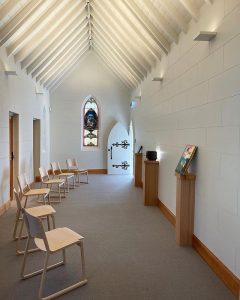


Blessed Sacrament Chapel. Good Samaritan Window (1885). Polding Altar Stone (19th Century).
What was previously known as a Visitors’ Chapel, off the main chapel, has now become an intimate, beautiful setting for private prayer: the Blessed Sacrament Chapel. The three foci in this space are the tabernacle from the sisters’ former chapel at Arncliffe, the Book of the Gospels carried in procession from this space to larger college liturgies in the hall, and an Altar-Stone, one of several, brought to Australia by Archbishop Polding. As far as can be ascertained from information in the Freeman’s Journal (3.4.1880), this altar stone, graced the sisters’ original chapel in Pitt St Sydney (1857) and then the Rosebank Chapel from 1880–1965. Well might we reflect on the numbers of people over the years who have been gathered into one and partaken of the Body and Blood of the Risen Christ around this precious stone. Finally, at the cemetery end of the Blessed Sacrament Chapel a stained glass window of The Good Samaritan from the sisters’ previous home at Arncliffe has been installed with its original dedication to the deceased children of St Magdalene’s Retreat (1885).
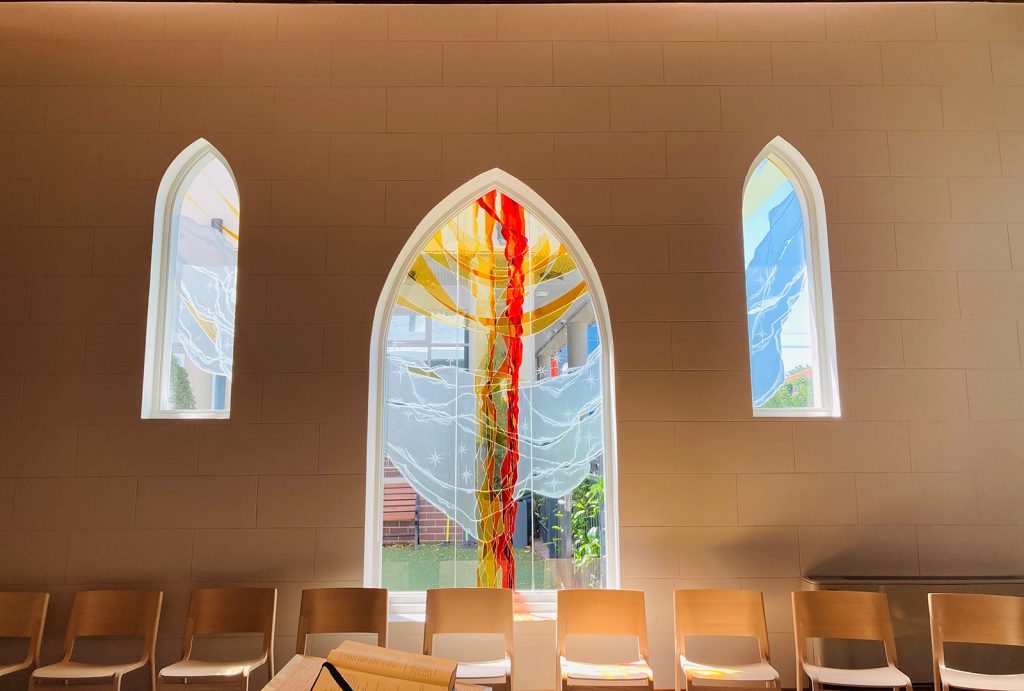
Three other stained glass windows have been newly designed by the internationally-known artist, Paddy Robinson, and installed in the main body of the chapel allowing sparkling light to pour into the sacred space. The large, new window has been placed into what was a door into the chapel (Gothic shaped) from the original convent while the two smaller windows on either side of this were discovered hidden in the structure during the refurbishment. Together they make a glorious design of the journey, in Christ, of all who have been part of the Rosebank story. These new windows companion some glorious Sydney made stained glass windows from earlier times in the colony (Ashwin and Falconer). The colour that sweeps across the body of the chapel throughout the day creates another way of lifting the mind and heart to God.
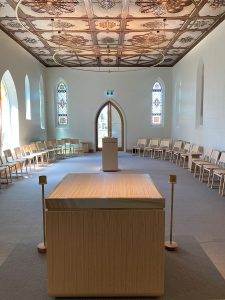

In the beautifully restored cemetery are buried 38 sisters, including two Poor Clare Sisters (one of whom was the abbess) who were too poor to buy grave plots. The cemetery was active from 1879–1899. In 1945, the remains of Scholastica Gibbons rsc (co-foundress) and Agnes Hart sgs (the longest living member of the founding group) were translated from Rookwood Cemetery to Rosebank to be buried with the early sisters. The youngest sister to be buried in the cemetery was Aloysius Cassidy sgs at nineteen years of age. Aloysius went to school at Rosebank and was the sister of Agatha Cassidy sgs, the first Australian sister to enter the congregation, founding principal of Rosebank College and, significantly, the designer of the ceiling in the chapel, now restored and so delicately lit.
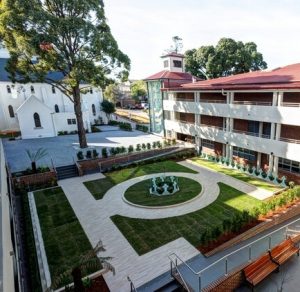
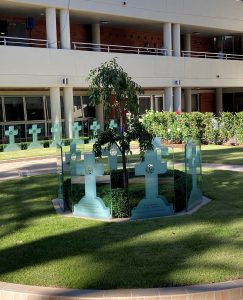
The 140 year old cemetery uses modern techniques of glass panels etched with the original cross design marking each sister’s grave. It has been restored to honour the lives of these remarkable women from the nineteenth century – women who walked the streets of Sydney visiting the poor, the vulnerable and the marginalised in the fledgling colony. These were women who accompanied Polding on his missionary journeys, who established schools and orphanages, who prayed in this chapel and walked in these grounds.
This significant site (the chapel and cemetery) in the grounds of Rosebank College enshrines treasured memories and fosters prayer and worship. At the completion of this project we can truly say that this community ‘evangelises not only through words and works, but also through its liturgy, its liturgical arts’ [1] and its beautiful place of worship.
Elizabeth Brennan sgs has been liturgical and arts consultant for this project.
[1] Fit for Sacred Use : Stewardship and renewal of places of worship. Australian Catholic Bishops’ Conference 2018. Par 729.
